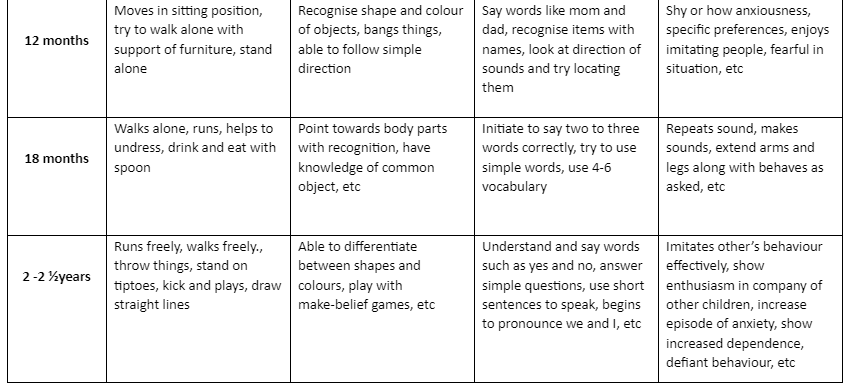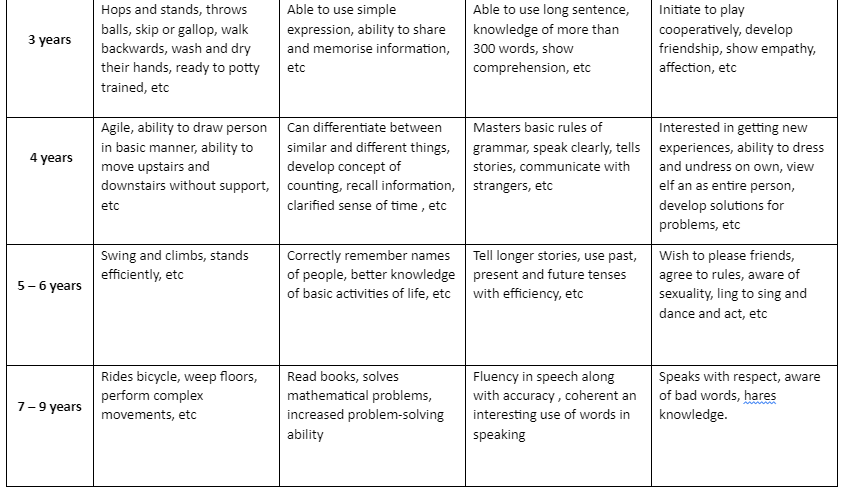Understand Children’s Learning and Behaviour in Relation to Sequence
- 19 Pages
- Published On: 18-11-2023
Plan 7 - Welcome to your Home Based Childcare Award (HBCA)
As you are aware, working in the early years sector comes with a great responsibility and in return is a rewarding role. Throughout the live webinars, alongside using your membership to access PACEY resources, we will be supporting you to understand and provide evidence to meet the CACHE criteria for you to achieve your Level 3 HBCA.
The live webinar teaching session to support plan 7 can be accessed using the pink “files from course” square on your portfolio home page. Here you can see a timetable of all the live webinars for the month. In addition to this there is a recorded webinar on this subject. Please select the “webinar links” document attached in your orange resources square.

Live Webinar - https://thechildcarecompany.adobeconnect.com/pacey/
Recorded Webinar - https://thechildcarecompany.adobeconnect.com/pau7zkiy160x/
Please see last page of this plan for further guidance to help support you.
Unit 1- Learning outcome 7: Understand children’s learning and behaviour in relation to sequence, rate and stage of development
In this learning outcome youwill explore learning and behaviour and why some children may display challenging behaviour or not be meeting expected milestones.
C3AHBC1-7.1 Identify areas of learning and development in relation to current frameworks.
C3AHBC1-7.2 Explain factors which influence children's development.
C3AHBC1-7.3 Explain the difference between sequence of development and rate of development.
C3AHBC1-7.4 Describe key milestones in development for children from birth to 12 years in relation to:
- physical development
- social and emotional development
- cognitive development
- speech, language and communication development
C3AHBC1-7.5 Explain how children's learning is influenced by:
- • positive relationships
- • environment
Looking for further insights on Children's Creativity? Click here.
C3AHBC1-7.6 Describe factors that influence children's behaviour.
C3AHBC1-7.7 Outline strategies for managing children's behaviour.
Verbs Explained –
Describe - Write about the topic giving detailed information
Explain - Give clear detailed information giving reasons, and showing how or why
Identify - List or name the main points
Outline - Identify briefly the main points
In this assignment you need to meet Assessment Criteria 7.1, 7.2, 7.3, 7.4, 7.5, 7.6 & 7.7
Assessment Criteria: 7.1 - Identify areas of learning and development in relation to current frameworks
- Identify the current Framework
- Name all 7 areas of learning as described on pages 7 & 8 of the EYFS
- Group the areas of learning into prime and specific areas of learning
- Explain briefly why they are divided in this way
The key areas of learning and development in relation to Early Year Foundation Stage (EYFS) are as follows:
- Physical development and learning (Prime area of learning)
- Communication and language (Prime area of learning)
- Social, emotional and personal development (Prime area of learning)
- Mathematics and numeracy (Specific area of learning)
- Understanding the world (Specific area of learning)
- Writing and reading (Specific area of learning)
- Expressive design and arts (Specific area of learning) (foundationyears.org.uk, 2017)
The areas of learning are divided into prime and specific areas of learning. The division is made because the prime areas indicate the kills to be learned that are fundamental need for the children to grow knowledge in working together and move through supportive action. However, the specific area of learning indicates the essential skills along with knowledge to be learned in successfully living within the society (foundationyears.org.uk, 2017). Thus, the division in the area of learning allows the child to understand which skill are fundamental and which are societal need that they are to learn to become a proper individual.
Assessment Criteria: 7.2 - Explain factors which influence children’s development.
External factors e.g.
- Poverty (may impact on diet, opportunities to play, housing conditions)
- Family background
- Choices children make
- Being in care (looked after children)
Personal factors e.g.
- Influences before, during and after birth
- Health status
- Disability
You need to provided 3 or 4 examples of external and 3 or 4 examples of personal factors, explain how they impact on development.
The personal factors that impact child development are:
- Health status: The presence of enhanced health status without disability leads the children to remain physically and mental strong to learn societal norm and function accordingly along with perform strengthen physical actions that are required for their proper growth and development (Cebotari et al., 2017).
- Nutrition: The presence of enhanced nutrition availability support improved child development as the required nutrients such as vitamins, minerals and others for early and strong growth of the body to support child development is easily accessed (De and Chattopadhyay, 2019).
- Heredity influences: The heredity which is transmission of certain genes and physical characters from parents affects child development as it dictates the texture of hair, intelligence level, heart health and others to be present in the child (Parhi, 2019).
The external factors that influence child develop are:
- Poverty: The living in poverty lead the children to deprived of required nutritional food and living condition which in turn makes them develop poor health (Chaudry and Wimer, 2016).
- Environment: The living in unhygienic environment leads the children develop various diseases during the early years which acts to bar proper growth and development in them out of hindered health condition (Planalp et al., 2017).
- Care by parents: The effective care by parents towards the children where they are provided timely breastfeeding, vaccination and other support required in their growing year proves to enhance their health condition and support proper growth (Felfe and Lalive, 2018).
Assessment Criteria: 7.3 - Explain the difference between sequence of development and rate of development.
You need to explain the difference between sequence and rate of development and give examples of how the rate can vary.
The sequence of development is normal sequential growth over the year where children learn different skill and knowledge whereas the rate of development is the speed with which child is developing or growing (Talbott et al., 2020). For example, sequence of development in case of child is that at first learn to roll followed by crawling, then sitting and standing with support to finally orient in learning to walk gradually. However, the rate of development, in this case, is the time taken in completing the walking development by the child which varies from person to person that is one child can start walking by 1.5 years of age another may take 2 years to finally start walking efficiently without support.
Assessment Criteria: 7.4 - Describe key milestones in development for children from birth to 12 years in relation to:
- physical development
- social and emotional development
- cognitive development
- speech, language and communication development
Please complete the chart below, the first one has been done for you. All ages need to be covered.
CHILD DEVELOPMENT CHART




Assessment Criteria: 7.5 - Explain how children’s learning is influenced by:
- positive relationships
- environment
Include the following –
- A link to page 6 of the statutory framework (EYFS) principles that identify children learn to be strong and develop well through positive relationships and an enabling environment.
- An acknowledgement that theories of child development have recognised that children need secure attachments in order to reach their full potential (e.g. John Bowlby).
- How emotional security benefits a child and how you can provide this as a home childcarer.
- How a sense of well-being and good self-esteem influences development and how you can support children to develop traits.
- What a quality learning environment looks like.
- Some examples of how you can provide this as a home child-carer.
- How this type of environment has a positive influence on children.
The EYFS principle mentions that each child is unique in their own way and try to be resilient, confident, capable and self-assured through positive relationship. The positive relationship leads the children to express themselves without fear and develop queries to be resolved effectively which make them independent and strong. The presence of enabling environment influence children learning and development by making them develop effective experiences through observation and interaction with practitioners and carers regarding specific needs (foundationyears.org.uk, 2017).
The Blowby’s theory mentioned that children are biologically-programmed with the tendency of seeking and remaining close to their attachment figures. The child wishes to remain close to the attachment figures as it makes them feel protected from the dangers in the environment. Thus, enabling environment where children can make effective attachment with their loved ones influences them to learn more effectively out of lack of fear and confusion raised due to dangers of the world which creates barriers towards their effective education (Granqvist, 2021).
The presence of good emotional security benefits the child to feel safe and secured to learn and develop accordingly. Moreover, it benefits them to develop enhanced confidence in exploring wider environment and ease in overcoming challenges on the world (Sela et al., 2019). The emotional security to children as home childcarer is to be established by showing empathy and understanding of the feelings of the child without any judgement from their perspective (Sela et al., 2019).
The sense of enhanced self-esteem and well-being can be developed for the child for supporting their growth by forming warm and loving relationship with them as it makes the children feel worthy of themselves and being valued that are the basis for development of their self-esteem and well-being (Mansfield et al., 2018). The children are to be supported in developing traits by explaining to them regarding the meaning of different traits, way and where they are to be implemented, way they can be evaluated to be positive or negative. Moreover, the use of drama, storytelling, fables and task card could be used in education children regarding the way to develop various traits (Putri et al., 2017).
A quality learning environment looks like presence of safe platform for the learners to be used where they are welcomed, supported and respect for any of the choices made by them. Moreover, presence of delivering education by following effective policies and legislation set by the government along with code of conducts by the educators been effectively performed led to development of good learning environment for learners (Syrjämäki et al., 2017). For example, positive learning environment as a child carer can be set by me by creating a learning environment for the children where they are not judged for their choice and they are made to feel safe to progress to any form of learning.
The presence of quality learning environment impacts the children to show enhanced attention, lower anxiety and supports showing improved emotions and behaviour in the environment. Moreover, it fosters an enhanced learning culture where learners develop high motivation and encouragement to learn and meet learning outcome with excellence (Junge et al., 2021).
Assessment Criteria: 7.6 - Describe factors that influence children’s behaviour.
Describe 5 of the following and how they influence children’s behaviour –
- Overall development
- Self-image
- Family
- Changes in a child’s life
- A child’s personality
- School and nursery
- Peer groups
- Influence of the media
The factors that influence child’ behaviour:
Discover additional insights on Communicating Strategically by navigating to our other resources hub.

- Family acts as first educator to the child and their positive learning supports leads the children to learn positive and negative behaviour in the society (Villardón-Gallego et al., 2018)
- Self-image promotes positive self-esteem and feeling of self-love by the children which makes them feel mentally stable to effectively participate in learning and showing proper behaviour (Villardón-Gallego et al., 2018)
- School and nursery educates children about the moral actions in life and thus they influences the children to develop moral behaviour (Villardón-Gallego et al., 2018)
- Media influences the children to habituate actions as it acts as view of the society for them (Villardón-Gallego et al., 2018)
- Peer groups are mainly friends of the children who influences the children to understand the way they are to behave with one another in the society (Villardón-Gallego et al., 2018)
Assessment Criteria: 7.7 - Outline strategies for managing children’s behaviour.
You need to show –
- You are aware that the EYFS requires you to manage behaviour in an appropriate way (page 28/29 sections 3.52 and 3.53 of the EYFS).
- You have an understanding that some behaviours are associated with particular stages of development and that you have suitable strategies in place to pre-empt and manage these types of behaviour.
- You’re aware of the need for consistency and reinforcement of boundaries.
- Your strategies take into account other influences that may be impacting on behaviour.
- You know how to get support with challenging behaviour.
The strategies according to EYFS in managing children behaviour are as follows:
The childcare providers are to create enhanced ground rules to be appropriately followed by the child in managing positive behaviour as the rules guide the child regarding the do’s and don’ts of behaviour to be followed in the society (foundationyears.org.uk, 2017). The care providers are to avoid providing the threat of corporal punishment to the children as it hinders their well-being out of fear and insecurity created by the threat and often instigate them to continue the behaviour. Instead, the care providers are required to take reasonable steps to guide the child regarding the way they are to avoid making any offensive behaviour because it makes the child to understand the reason of changing their behaviour through positive action (foundationyears.org.uk, 2017).
In the early childhood stage, the children show increased behaviour of developing attachment with their loved ones so that they can feel safe and secured. In order to support development of this behaviour at the childhood stage, as a carer I need to be open and show concern along with love and care toward the children so that they understand the positive traits to be considered in developing attachment behaviour (Ogundele, 2018). In the middle childhood stage, one of the behaviours showed by children is increased understand of concepts and facts regarding time and money. The strategy to support development of this behaviour is informing the children regarding the way they can earn money and value its presence (Howard et al., 2017).
The consistency and reinforcement of boundaries for the children are to be developed by focussing of their behavioural priority and negative behaviour developed by them. A tangible reminder and assistance are to be reinforced to make children understand way to make their positive behaviour consistent (Barnett and Ackerman, 2020).
A well-developed plan is to be made that supports development of positive behaviour in children and it is to be followed in teaching them expected positive behaviour to be learned and practiced. Moreover, monitoring of the children is to be executed regarding the showcasing of their behaviour to understand where they are making mistakes that are to be resolved in time to make them develop and continue positive behaviour (Roche, 2018).
The challenging behaviour in children are to be managed by initially communicating with the children to understand the factors which are leading to such behaviour so that those can be controlled to support them develop positive behaviour. Moreover, mental health professionals and behaviour management specialist are to be involved in supporting effective management of challenging behaviour of children. Moreover, the parents and families of the children showing challenging behaviour are to be involved by the learners to determine factors that are leading to the situation so that together they can control the factors to support enhanced behaviour management in children (Shih et al., 2018).
Congratulations, you have completed this plan, it is ready to be submitted for assessment and for you to receive feedback on your progress.
Continue your exploration of To Gather the Views of fellow Somali Students on the Factors with our related content.
References
- Barnett, W.S. and Ackerman, D.J., 2020. Boundaries with early childhood education: The significance of the early childhood frontier for elementary and secondary education. In The state of education policy research (pp. 187-202). Routledge.
- Cebotari, V., Mazzucato, V. and Siegel, M., 2017. Child development and migrant transnationalism: The health of children who stay behind in Ghana and Nigeria. The Journal of Development Studies, 53(3), pp.444-459.
- Chaudry, A. and Wimer, C., 2016. Poverty is not just an indicator: The relationship between income, poverty, and child well-being. Academic pediatrics, 16(3), pp.S23-S29.
- De, P. and Chattopadhyay, N., 2019. Effects of malnutrition on child development: Evidence from a backward district of India. Clinical Epidemiology and Global Health, 7(3), pp.439-445.
- Felfe, C. and Lalive, R., 2018. Does early child care affect children's development?. Journal of Public Economics, 159, pp.33-53.
- Granqvist, P., 2021. Attachment, culture, and gene-culture co-evolution: expanding the evolutionary toolbox of attachment theory. Attachment & human development, 23(1), pp.90-113.
- Howard, J., Miles, G.E., Rees‐Davies, L. and Bertenshaw, E.J., 2017. Play in middle childhood: Everyday play behaviour and associated emotions. Children & Society, 31(5), pp.378-389.
- Junge, K., Schmerse, D., Lankes, E.M., Carstensen, C.H. and Steffensky, M., 2021. How the home learning environment contributes to children's early science knowledge—Associations with parental characteristics and science-related activities. Early Childhood Research Quarterly, 56, pp.294-305.
- Mansfield, L., Kay, T., Meads, C., Grigsby-Duffy, L., Lane, J., John, A., Daykin, N., Dolan, P., Testoni, S., Julier, G. and Payne, A., 2018. Sport and dance interventions for healthy young people (15–24 years) to promote subjective well-being: a systematic review. BMJ open, 8(7), p.e020959.
- Ogundele, M.O., 2018. Behavioural and emotional disorders in childhood: A brief overview for paediatricians. World journal of clinical pediatrics, 7(1), p.9.
- Parhi, K., 2019. Heredity as a burden: causes of children’s behavioural problems in Finnish psychiatry between the 1920s and 1950s. Palgrave Communications, 5(1), pp.1-8.
- Planalp, E.M., Van Hulle, C., Lemery-Chalfant, K. and Goldsmith, H.H., 2017. Genetic and environmental contributions to the development of positive affect in infancy. Emotion, 17(3), p.412.
- Putri, M.A., Harto, S. and Moecharam, N.Y., 2017. Promoting character education in EFL classroom: Using children’s literature as a teaching material. Journal of English and Education, 5(2), pp.163-169.
- Roche, L., 2018. The power of choice for toddlers: A rationale for implementing choice theory in the early childhood classroom. International Journal of Choice Theory® and Reality Therapy, 37(2), p.50.
- Rucinski, C.L., Brown, J.L. and Downer, J.T., 2018. Teacher–child relationships, classroom climate, and children’s social-emotional and academic development. Journal of Educational Psychology, 110(7), p.992.
- Sela, T., Livni, T. and Feniger-Schaal, R., 2019. The point of no return: A drama therapy group intervention for parents of children with ADHD. Drama Therapy Review, 5(2), pp.235-249.
- Shih, E.W., Quiñones‐Camacho, L.E. and Davis, E.L., 2018. Parent emotion regulation socializes children's adaptive physiological regulation. Developmental psychobiology, 60(5), pp.615-623.
- stanfordchildrens.org 2019, The Growing Child: School-Age (6 to 12 Years), Available at: https://www.stanfordchildrens.org/en/topic/default?id=the-growing-child-school-age-6-to-12-years-90-P02278 [Accessed on: 20 October 2020]
- Syrjämäki, M., Sajaniemi, N., Suhonen, E., Alijoki, A. and Nislin, M., 2017. Enhancing peer interaction: an aspect of a high-quality learning environment in Finnish early childhood special education. European Journal of Special Needs Education, 32(3), pp.377-390.
- Talbott, M.R., Young, G.S., Munson, J., Estes, A., Vismara, L.A. and Rogers, S.J., 2020. The developmental sequence and relations between gesture and spoken language in toddlers with Autism Spectrum Disorder. Child development, 91(3), pp.743-753.
- Villardón-Gallego, L., García-Carrión, R., Yáñez-Marquina, L. and Estévez, A., 2018. Impact of the interactive learning environments in children’s prosocial behavior. Sustainability, 10(7), p.2138.
- Waite, S. ed., 2017. Children learning outside the classroom: From birth to eleven. Sage.
Further Guidance
Guidance to help me –
PACEY Membership (https://www.pacey.org.uk/) –
My Pacey
- Resources
Child Development
- Resources
All Factsheets An A-Z list
EYFS Areas of Learning
Child Development Basics
Managing Feelings and Behaviour
Video (from NSPCC) – Brain Development
https://www.youtube.com/watch?v=hMyDFYSkZSU
This video explains how experiences in the first years of our lives affects how out brains form.
Video (from NHS Health Scotland) – Adverse Childhood Experiences https://www.youtube.com/watch?v=VMpIi-4CZK0 Raising awareness about the impact of childhood adversity.
Video – The Attachment Theory https://www.youtube.com/watch?v=WjOowWxOXCg This video looks at how bonds with the primary caregiver affects childhood
Video (from Raising Children Network) – Encouraging Behaviour https://www.youtube.com/watch?time_continue=1&v=1QI_uv5c_tw&feature=emb_logo The video includes tips on strategies to avoid hitting, tantrums and whining.
Free Online Training
Understanding Adverse Childhood Experiences
https://www.acesonlinelearning.com/
This course has 7 modules that take 50 minutes to complete. At the end of the course you will receive a certificate.
The modules are:
1 Introduction to identifying adverse experiences
2 Brain Development in Early Years
3 Impact of childhood adversity
4 Social, health and community Impacts of ACE’s Early Trauma
5 Protective Factors
6 Looking at ACEs through a trauma informed lens
7 Building Resilience
Websites:
https://www.foundationyears.org.uk/files/2012/03/Development-Matters-FINAL-PRINT-AMENDED.pdf
https://www.goodtoknow.co.uk/family/child-development-stages-ages-6-12-4735 – Child development stages: 6-12 the mid years
https://wehavekids.com/parenting/What-Influences-Child-Development – Environmental factors that influence areas of child development
https://www.verywellmind.com/child-development-theories-2795068 – Child development theories
https://www.nhs.uk/conditions/social-care-and-support-guide/caring-for-children-and-young-people/how-to-deal-with-challenging-behaviour-in-children/ - How to deal with challenging behaviour in children
If you require any further support, please do not hesitate to contact me via email or join me at one of the ‘live webinars’ via the webinar link on your portfolio home page.
Kind regards,
The Home-Based Childcare Team
- 24/7 Customer Support
- 100% Customer Satisfaction
- No Privacy Violation
- Quick Services
- Subject Experts



